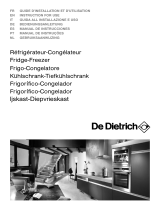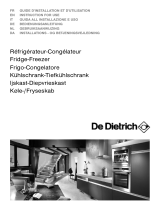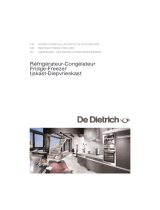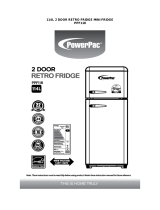SAFETY INSTRUCTIONS
This appliance is intended for domestic use only. It has been
designed for preserving and freezing food.
The following instructions are for your own safety and
should be observed without fail. We can neither be held res-
ponsible, nor uphold the guarantee in case of failure to
observe these recommendations, which may Iead to mate-
rial damage or physical injury.
Your appliance must be installed, fixed if necessary and used in
compliance with the instructions in this operating and installation
instructions manual in order to avoid any damage and /or danger
due to any lack of stability or faulty installation.
If the appliance has been delivered to your home in a hori-
zontal position, stand it upright and then wait 2 hours before
plugging it in. A small amount of oil may have flowed into
the refrigeration circuit, and you must allow time for this to
flow back towards the motor before connecting the
appliance. Failure to do so may damage the appliance.
If you appliance is fitted with wheels, please remember that they
are only designed to assist in small movements. Do not use them
for longer journeys.
Carry out an initial cleaning operation (see the section on lnstal-
ling your appliance) before connecting your appliance to the
electrical supply. Disconnect your appliance prior to performing
any maintenance operation. Grasp the plug directly, instead of
pulling on the power cable.
Do not place bottles or jars containing liquids in the freezer
unless they are only two-thirds full, freezing causes liquids to
expand, which can cause the container to explode.
Do not use any other method than those we recommend in this
manual for speeding up defrosting.
Do not use electrical equipment inside compartments designed
for preserving frozen food unless the manufacturer recommends
otherwise.
Do not let children play with the appliance and keep your pets
well away from it. Worn out appliances must be rendered unusa-
ble. Unplug and cut the electric cable flush with the
appliance.Render the door catch unusable or, better still, remove
the door, so as to ensure that no child or animal risks being shut
inside whilst playing.
If a problem arises that you are unable to resolve using the
advice given (see the Ongoing maintenance section), please
contact an official after-sales service or a qualified professional.
Danger:
Your appliance’s refrigeration circuit is filled with isobu-
tane refrigerant (R600a), a natural, non-polluting gas that
is, however, inflammable. Ensure that none of the compo-
nents in your applia nce’s refrigeration circuit have been
damaged during transport or installation. If you detect any
damage, keep your appliance away from flames or any
type of source of heat or combustion and ventilate its loca-
tion.
This appliance is not intended for use by persons (including chil-
dren) with reduced physical, sensory or mental capabilities, or
lack of experience and knowledge, unless they have been given
supervision or instruction concerning use of the appliance by a
person responsible for their safety.
Children should be supervised to ensure that they do not play
with the appliance.
ENVIRONMENTAL PROTECTION
This appliance’s packaging material is recyclable. Help recycle it
and protect the environment by dropping it off in
municipal receptacles provided for this purpose.
Your appliance also contains a great amount of recyclable mate-
rial. It is marked with this label to indicate the used
appliances that should not be mixed with other waste.
This way, the appliance recycling organised by your
manufacturer will be done under the best possible condi-
tions, in compliance with European Directive 2002/96/EC
on Waste Electrical and Electronic Equipment. Contact your
town hall or your retailer for the used appliance collection points
closest to your home.
We thank you doing your part to protect the environment.
SAVING ENERGY
To reduce your appliance’s electrical consuption:
- Install it in a suitable place (see” lnstallation of your appliance”
section).
- Leave the door open as little as possible. Do not place food that
is still hot in your refrigerator or freezer, particularly in the case of
soups or dishes that release a lot of steam.
- Ensure that you appliance operates optimally by not allowing
too much frost to build up in the freezer (defrost it when the frost
is more than 5-6 mm thick) and clean its condenser periodically
(See the Ongoing maintenance your appliance section).
- Periodically check the door seals and make sure that the doors
close firmly. If they do not, please contact our After-sales service.
In compliance with the Iatest legislation concerning environmen-
tal protection, your appliance does not contain any CFC. Instead
it uses a gas called R600a. The exact type of refrigerant used in
your appliance is also clearly indicated on the identification plate
inside your appliance’s refrigerator section, low down on the Ieft-
hand wall.
R600a is a non-polluting gas that does not harm the ozone layer
and whose contribution to the greenhouse effect is virtually zero.
1 SAFETY INSTRUCTIONS
EN
13











 1
1
 2
2
 3
3
 4
4
 5
5
 6
6
 7
7
 8
8
 9
9
 10
10
 11
11
Groupe Brandt SA1652E Owner's manual
Groupe Brandt BFC5856NX Owner's manual
Groupe Brandt DZV4601TS Owner's manual
Groupe Brandt DFV450WK Owner's manual
Groupe Brandt DNF450WK Owner's manual
Groupe Brandt DZN4210 Owner's manual
Groupe Brandt VNF5000WK Owner's manual
Groupe Brandt VFV4800WK Owner's manual
Groupe Brandt RBS438 Owner's manual
Groupe Brandt RCN318 Owner's manual
Candy CO CFU 130 K User manual
 De Dietrich DKD855X Owner's manual
De Dietrich DKD855X Owner's manual
De Dietrich DKD845S Owner's manual
 De Dietrich DKT863X Owner's manual
De Dietrich DKT863X Owner's manual
 De Dietrich 6335DN Owner's manual
De Dietrich 6335DN Owner's manual
De Dietrich 6355DNX Owner's manual
Groupe Brandt SFVA352 Owner's manual
Groupe Brandt FD-291NF Owner's manual
Nordmende RIUL 140 Owner's manual
 PowerPac PPF118 114L 2 Door Retro Fridge Mini Fridge User manual
PowerPac PPF118 114L 2 Door Retro Fridge Mini Fridge User manual














